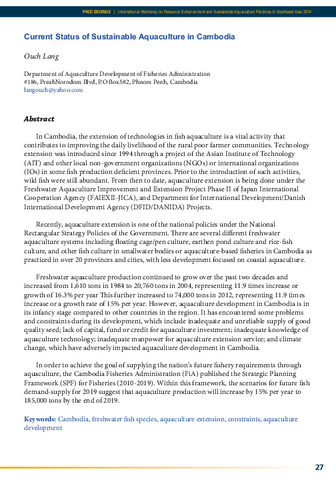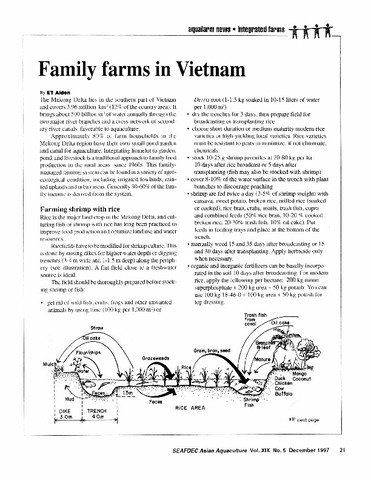Current status of sustainable aquaculture in Cambodia
- Global styles
- MLA
- Vancouver
- Elsevier - Harvard
- APA
- Help
Share
นามธรรม
In Cambodia, the extension of technologies in fish aquaculture is a vital activity that contributes to improving the daily livelihood of the rural poor farmer communities. Technology extension was introduced since 1994 through a project of the Asian Institute of Technology (AIT) and other local non-government organizations (NGOs) or international organizations (IOs) in some fish production deficient provinces. Prior to the introduction of such activities, wild fish were still abundant. From then to date, aquaculture extension is being done under the Freshwater Aquaculture Improvement and Extension Project Phase II of Japan International Cooperation Agency (FAIEXII-JICA), and Department for International Development/Danish International Development Agency (DFID/DANIDA) Projects.
Recently, aquaculture extension is one of the national policies under the National Rectangular Strategy Policies of the Government. There are several different freshwater aquaculture systems including floating cage/pen culture, earthen pond culture and rice-fish culture, and other fish culture in smallwater bodies or aquaculture-based fisheries in Cambodia as practiced in over 20 provinces and cities, with less development focused on coastal aquaculture.
Freshwater aquaculture production continued to grow over the past two decades and increased from 1,610 tons in 1984 to 20,760 tons in 2004, representing 11.9 times increase or growth of 16.3% per year This further increased to 74,000 tons in 2012, representing 11.9 times increase or a growth rate of 15% per year. However, aquaculture development in Cambodia is in its infancy stage compared to other countries in the region. It has encountered some problems and constraints during its development, which include inadequate and unreliable supply of good quality seed; lack of capital, fund or credit for aquaculture investment; inadequate knowledge of aquaculture technology; inadequate manpower for aquaculture extension service; and climate change, which have adversely impacted aquaculture development in Cambodia.
In order to achieve the goal of supplying the nation s future fishery requirements through aquaculture, the Cambodia Fisheries Administration (FiA) published the Strategic Planning Framework (SPF) for Fisheries (2010-2019). Within this framework, the scenarios for future fish demand-supply for 2019 suggest that aquaculture production will increase by 15% per year to 185,000 tons by the end of 2019.
การอ้างอิง
Lang, O. (2015). Current status of sustainable aquaculture in Cambodia. In M. R. R. Romana-Eguia, F. D. Parado-Estepa, N. D. Salayo, & M. J. H. Lebata-Ramos (Eds.), Resource Enhancement and Sustainable Aquaculture Practices in Southeast Asia: Challenges in Responsible Production of Aquatic Species: Proceedings of the International Workshop on Resource Enhancement and Sustainable Aquaculture Practices in Southeast Asia 2014 (RESA) (pp. 27-40). Tigbauan, Iloilo, Philippines: Aquaculture Dept., Southeast Asian Fisheries Development Center.
Type
Conference paperISBN
9789719931041
Related items
Showing items related by title, author, creator and subject.
-
The Philippine aquaculture industry
Camacho, Arsenio S.; Macalincag-Lagua, Natividad (Aquaculture Department, Southeast Asian Fisheries Development Center, 1988)The aquaculture sector of the Philippine fishing industry registered the highest growth rate of 12.5% in 1977-1986. The contribution of aquaculture to the total fish production was equivalent to 24% in 1986 compared to ... -
Family farms in Vietnam
Aldon, Eva T. (Aquaculture Department, Southeast Asian Fisheries Development Center, 1997) -
Nursery and grow-out operation and management of Penaeus monodon (Fabricius)
Corre, Kaylin G. (Aquaculture Department, Southeast Asian Fisheries Development Center, 1988)The results of research on nursery and grow-out rearing of prawn conducted by the SEAFDEC Aquaculture Department for over a decade are reviewed. Different rearing facilities designed to accommodate hatchery-produced prawn ...






